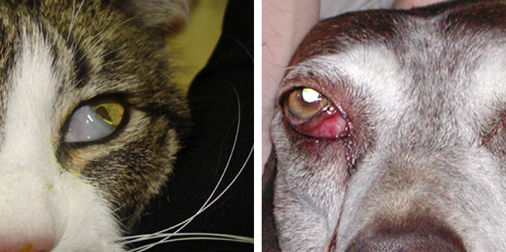
Anatomy Of The Eye

CLICK ON THE EYE FOR ADDITIONAL INFORMATION
When considering the anatomy of the eye, it is important to first consider the orbit as a whole.
The orbit is the term used to describe the region which contains the extraocular muscles, nerves and blood vessels, the lacrimal gland, the optic nerve and of course the eye itself.
Given the orbit forms a relatively enclosed space, any changes to the structures within it can have an effect on the entire contents. An increase in volume, caused by space occupying lesions, can lead to the eye being moved forwards within its orbit.
Clinically, this presents as exophthalmos, often with third eyelid protrusion. The more common conditions of the orbit which may cause exophthalmos include retrobulbar abscesses, cysts, neoplasms and myositis of surrounding musculature. Conversely, if the volume of contents reduces, the eye can move backwards within the orbit, presenting as enophthalmos

The lacrimal system is made up of multiple different components which have two main functions.
The first function is secretion of the tear film. The tear film covers both the conjunctiva and the cornea and is integral to the health of these structures. The actions of the tear film include lubrication, cleansing/disinfection and supply of nutrients and oxygen to the cornea. It is important to evaluate the tear film where conjunctival or corneal disease is present.
The second function of the lacrimal system is excretion. Around 25% of the tear film is lost by evaporation, however the remainder drains into lacrimal puncta through their associated canaliculi, through the lacrimal sac, the nasolacrimal duct and eventually ending up in the nasal cavity.
Problems with the lacrimal system can include issues with:
• Secretion and/or distribution of the tear film or its components
• Drainage (either due to overproduction of tears or failure of excretion)